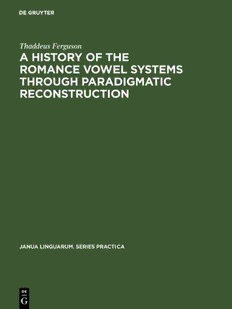
A History of the Romance Vowel Systems through Paradigmatic Reconstruction PDF
Preview A History of the Romance Vowel Systems through Paradigmatic Reconstruction
JANUA LINGUARUM STUDIA MEMORIAE NICOLAI VAN WIJK DEDICATA edenda curai C. H. VAN SCHOONEVELD Indiana University Series Practica, 176 TO MY MOTHER A HISTORY OF THE ROMANCE VOWEL SYSTEMS THROUGH PARADIGMATIC RECONSTRUCTION by THADDEUS FERGUSON Columbia University 1976 MOUTON THE HAGUE • PARIS © Copyright 1976 Mouton & Co. B.V., Publishers, The Hague No part of this book may be translated or reproduced in any form, by print, photoprint, microfilm, or any other means, without written permission from the publishers. ISBN 90 279 3354 5 Printed in Hungary ACKNOWLEDGMENTS Since this study was originally undertaken as a Columbia University doctoral disserta- tion, I can do no less than to extend due recognition to those scholars who supervised it from its inception to its present form: to Professor Robert Austerlitz, who, as director of the dissertation, insisted on the highest standards at all times and whose constructive criticism has brought a measure of improvement to virtually every page of this work; to Professor Fredrick H. Jungemann, whose generous expenditure of time and effort far exceeded the call of duty; and to Professor Mario A. Pei, who graciously shared with me his unrivaled knowledge of the entire field of Romance philology. These three men deserve much of the credit for whatever there may be of value in this study; indeed, they are largely responsible for the training without which I could not have undertaken the project atall. I should also like to take this oppor- tunity to thank Professor Lawton P. G. Peckham and Professor Joseph L. Malone,. both of whom read the entire text and made a number of perceptive observations, some of which are reflected in the final version. In addition, congratulations are due to Mr. Ronald Stark for his expert typing of a difficult manuscript. The major portion of Chapter 10 first appeared in Studies in Honor of Mario A. Pei (Chapel Hill, 1972). I wish to thank North Carolina Studies in the Romance Languages and Literatures for permission to reprint this material. 5 CONTENTS Acknowledgments 5 Apparatus 9 Introduction 0.1. Aim 11 0.2. Latin and Proto-Romance 13 0.3. Structural Linguistics and Romance Historical Phonology: Some Pre- vious Studies 14 0.4. Methodology 18 PART I: THE RECONSTRUCTION OF THE PROTO-ROMANCE VOWEL PARADIGM 1. Preliminary Survey of Modern Romance Vowel Patterning 25 2. The Proto-Romance System of Stressed Vowels 37 3. The Proto-Romance System of Unstressed Vowels 70 4. The Proto-Romance Diphthong */aw/ 79 5. The Philological Evidence 85 PART II: RISING DIPHTHO NGIZ ATION AND MET APHONY IN ROMANCE 6. The Two Prototypes of Stressed Vowel Development 95 7. A Theory on the Diachronic Relationship between Rising Diphthongization and Metaphony 123 8. Sample Reconstruction: The Parallel Evolution of Spanish and Portuguese Stressed Mid Vowels 131 7 8 CONTENTS PART III: PATTERNED FALLING DIPHTHONGIZATION AND THE FRONT ROUNDED VOWEL SERIES 9. The Two Zones of Patterned Falling Diphthongization 139 10. Sample Reconstruction : The Evolution of the Stressed Vowel System of Vegliote 149 11. Conclusion 11.1. The Structure and Evolution of the Pro to-Romance Vowel Paradigm: Summary 164 11.2. The Question of Regional Isoglosses in Pro to-Romance 172 Bibliography 175 APPARATUS (1 j. Stress is indicated by /'/ before the stressed syllable; e.g., Central Italian /'par lo/ "I speak", /par '1 <?/ "he spoke". (2). Stress will not be indicated for standard French. It will be understood that the stress falls on the final syllable of isolated words of more than one syllable; e.g., /sa vSj = [sa 'v5] "soap". (3). The mid-close ~ mid-open distinctions for standard French /e/ and ¡of will not be indicated here in phonemic transcription except where absolutely necessary, as in certain minimal pairs like fzi re/ "I shall go" ~ /zi r?/ "I would go", /zon/ "fast" (noun) ~ /ZQD/ "young". The contrast /a/ ~ ¡A/, as in French /pat/ "paw" ~ /pat/ "dough, paste", will likewise be considered exceptional, and /a/ alone will be used to denote the vowel of maximum aperture in standard French. (4). The palatal and back labial (or labio-velar) glides are consistently transcribed here as /y/ and /w/ respectively, as in Spanish /byen/ "well", /'bwe no/ "good" m. sg. The front labial (or labio-palatal) glide is transcribed as /w/, as in French /kwis/ "thigh". (5). The symbols /./ and IJ are used to denote a difference of a single degree of aperture between vowels which are otherwise similar in articulation; e.g., mid- close /e/ in Central Italian /'pe lo/ "hair" vs. mid-open /?/ in Central Italian /'gr? ve/ "heavy, grievous". (6). The symbol denotes a vowel in open syllable, as in the case of Spanish and Central Italian /a | / in /'ka TO/ "dear" m. sg. The symbol | denotes a vowel in closed syllable, as in the case of Spanish and Central Italian /a [/ in /'kar ne/ "meat". (7). Subscript numerals are used in transcribing vocoids which enter into multiple sets of correspondences with vocoids or other phonic units in the sound system of another language; e.g., Logudorese /ii/ corresponds to Central Italian /if, as in Log. /'fi lu/:C. Ital. /'fi lo/ "thread"; while Logudorese /i / corresponds to Central Italian 2 /e/, as in Log. /'pi ra/:C. Ital. /'pe ra/ "pear". (8). The symbol /'/ is used to indicate palatalization, as in Central Italian /'fi Yof 9
